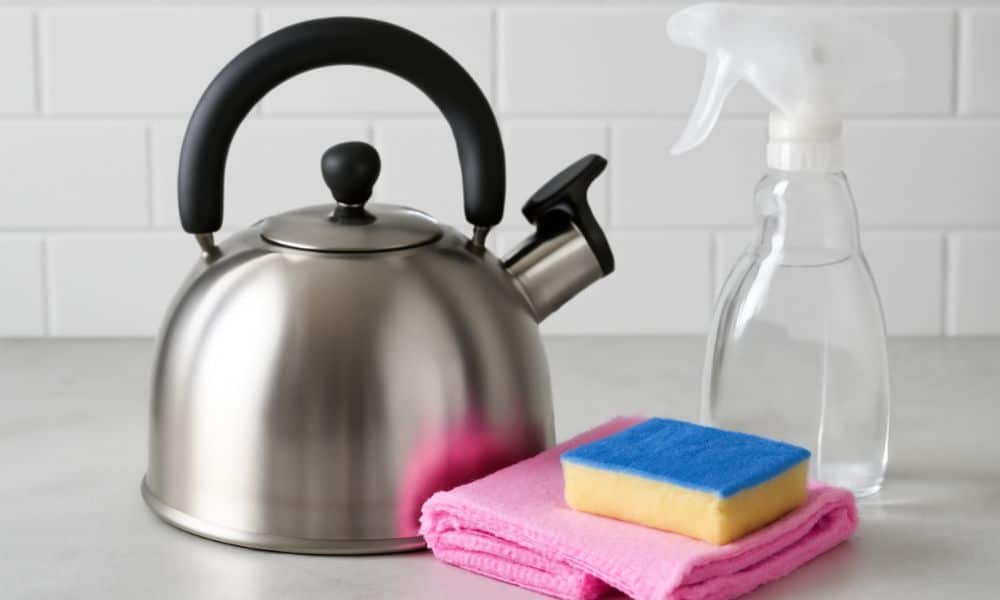The kettle hums. Steam rises. A soft whistle greets the dawn. Last year, my tea tasted dull. I checked the leaves, the cup, the water. Nothing helped. At last, I peeked inside the pot and met a grey coat of scale. I spent months testing every safe trick. Now I know the sure path on how to clean stainless steel tea kettle. The steps shine the metal and bring back its bright finish. Read on, grab your sponge, and start the scrub. Cleaning your kettle doesn’t need to be a chore. You can bring it back to life with just a few pantry staples and a little time. This method is simple, safe, and tested. Let’s walk through it together.
What You’ll Need
You don’t need much to get started. Here’s what I always keep on hand:
- White vinegar – works fast and smells clean
- Baking soda – lifts stains and freshens the pot
- Warm water – for rinsing and filling
- Soft sponge or cloth – to avoid scratching
- Clean towel – to dry the kettle after
The Cleaning Process
Follow these steps to remove buildup and make your kettle shine again.
Step 1: Fill with vinegar and water
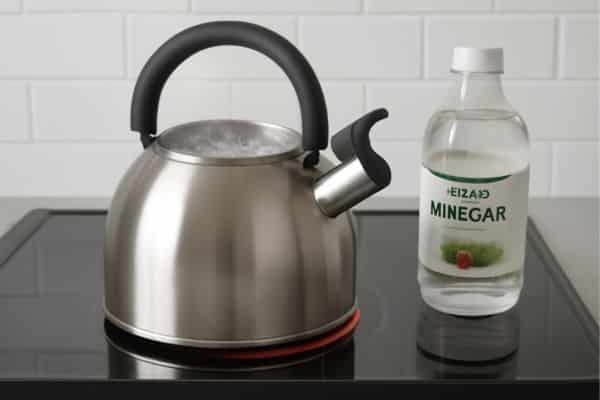
Fill your kettle halfway with equal parts white vinegar and water. This blend cuts through mineral deposits without harsh chemicals.
Step 2: Boil the solution
Turn on the heat and bring the mixture to a boil. This helps loosen any buildup inside.
Step 3: Let it sit and cool
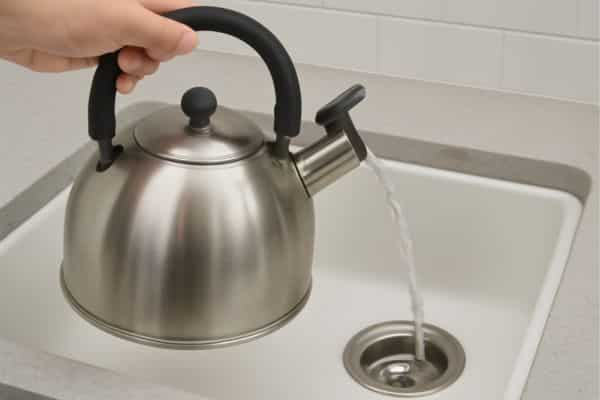
After boiling, turn off the heat and let the kettle sit for 15 minutes. The steam will work on the inside, while the vinegar will break down the grime.
Step 4: Empty and rinse
Carefully pour the liquid out. Then rinse the kettle with warm water. The inside should already look much better.
Step 5: Scrub with baking soda
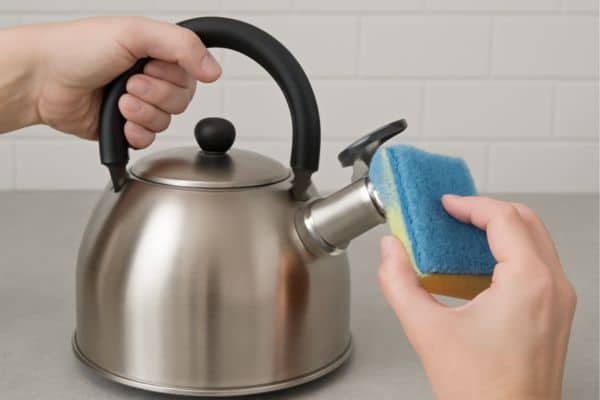
Dab a little baking soda on a damp sponge. Gently scrub inside and around the spout. This lifts leftover spots without scratching.
Step 6: Rinse and dry
Rinse well with clean water. Wipe the inside and outside dry with a soft towel to stop water marks from forming.
How Often Should You Clean Your Tea Kettle?
The more you use it, the more love it needs.
Use your kettle every day? Give it a light rinse and dry after each use. Once a week, do a deeper clean with vinegar and baking soda. This keeps limescale from building up and your tea tasting fresh.
Only use it now and then? A full clean every two to three weeks is enough. Just make sure no water sits inside for too long—it can leave marks or stale smells. For a healthier and safer option, consider investing in the best non-toxic electric tea kettle to ensure pure, clean water every time you brew.
Here are signs your kettle needs cleaning:
- White spots inside the base
- A dull or cloudy surface
- A sour or metallic taste in your tea
- Slower boil times
Bonus Tips from a Long-Time Kettle User
After years of morning brews and late-night herbal sips, I’ve picked up a few tricks that go beyond basic cleaning. These little habits make a big difference.
Stop Limescale Before It Starts
Limescale is sneaky. It forms from minerals in water and hides in corners. To slow it down, use filtered water in your kettle. It has fewer minerals, which means fewer spots. Empty it after each use so water doesn’t sit and harden.
Always Dry It Out
It’s easy to forget, but drying your kettle keeps it shining. After rinsing, wipe the inside and outside with a soft towel. This stops water spots and rust. Think of it like drying your favourite wine glass—same care, same glow.
Freshen the Inside with Simple Stuff
To clear out odours or stale water smells, fill your kettle with water and drop in a few lemon slices. Boil it, then let it cool. The lemon acts like nature’s reset button—fresh, clean, and safe.
Try a Quick Lemon Polish
For the outside, rub half a lemon over the steel. Let the juice sit for a minute, then wipe it off. It shines up the surface and leaves a clean citrus scent. I do this once a week for that extra sparkle.
Vinegar vs. Other Methods: What Works Best?
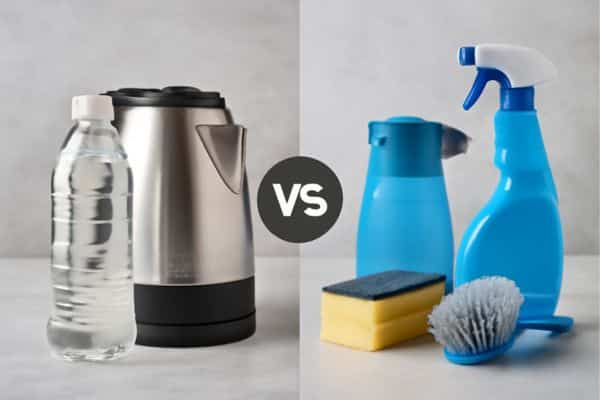
I’ve tried just about every way to clean a kettle. From store-bought sprays to old-school hacks. Some worked, some fizzled. But one method always comes through: vinegar.
Let’s break it down.
Why Vinegar Wins
Vinegar is cheap, natural, and safe. It melts away limescale and doesn’t scratch the steel. It also doesn’t leave any weird aftertaste once rinsed well. That’s why I always recommend how to clean the kettle with vinegar first. It’s the one method that works for both inside and outside.
Here’s how it helps:
- Breaks down mineral spots fast
- Leaves no film behind
- Safe for stainless steel
- No strong smell after boiling and rinsing
What About Commercial Cleaners?
Some commercial products promise speed. They may work faster, but many are too harsh for stainless steel. A few even leave behind strong scents or chemical residue. That’s not what you want near your tea.
If you go this route, check the label first. Make sure it says “safe for stainless steel” and has no bleach or acids that might corrode metal over time. Use it only for deep cleans, not daily upkeep
What Not to Do When Cleaning Your Kettle
A clean kettle is a happy kettle—but only if you treat it right. Here are a few things I’ve learned to avoid along the way.
No Steel Wool, Ever
Steel wool might seem like the fastest way to scrub off buildup, but it’s far too rough. It scratches the surface and leaves behind marks that won’t come out. Even worse, those tiny scratches make space for more grime to build up later. Use a soft sponge instead. Gentleness always wins.
Don’t Let Water Sit
Leaving water inside your kettle after use can lead to spots, rust, and a stale smell. Pour out the leftover water each time. Give it a quick wipe, and you’ll save yourself time later. Small habit, big payoff.
Skip Harsh Chemicals
Strong cleaners might cut through grease fast, but they’re too risky for your kettle. Some contain acids that damage stainless steel. Others leave behind smells that sneak into your next cup. Stick with vinegar, lemon, or baking soda. They’re kind to your kettle and your tea.
Final Thoughts
A clean kettle does more than shine. It brings better tea, better mornings, and a touch of peace to your day.
Taking care of it doesn’t need to be a big task. With a little vinegar, some warm water, and a soft cloth, you’re set. It takes just a few minutes to bring back that sparkle and keep every cup tasting right.
So give your kettle a rinse, a scrub, and a dry. Make it part of your tea-time ritual. It’s one of those small things that makes a quiet day feel just a bit more special.

